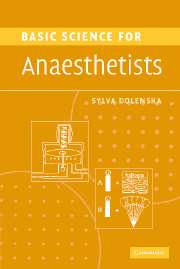Book contents
- Frontmatter
- Contents
- List of abbreviations and symbols
- List of figure captions
- Forewords
- Preface
- Preface to the second edition
- Part 1 Physics, mathematics, statistics, anaesthetic apparatus
- Part 2 Clinical measurement
- Part 3a Physiology: the cardiovascular system
- Part 3b Physiology: the respiratory system
- 1 Oxyhaemoglobin dissociation curve
- 2 Respiratory mechanics 1: Static properties, factors affecting compliance, closing volume
- 3 Respiratory mechanics 2: Dynamic properties, factors affecting resistance
- 4 Ventilation–perfusion relationship
- 5 Oxygen cascade, oxygen therapy and shunt fraction
- 6 Gas R line, solution of the ventilation/perfusion model
- 7 Ventilatory response to oxygen
- 8 Ventilatory response to carbon dioxide
- Part 4 Pharmacology
- Further Reading
- Index
7 - Ventilatory response to oxygen
from Part 3b - Physiology: the respiratory system
Published online by Cambridge University Press: 13 August 2009
- Frontmatter
- Contents
- List of abbreviations and symbols
- List of figure captions
- Forewords
- Preface
- Preface to the second edition
- Part 1 Physics, mathematics, statistics, anaesthetic apparatus
- Part 2 Clinical measurement
- Part 3a Physiology: the cardiovascular system
- Part 3b Physiology: the respiratory system
- 1 Oxyhaemoglobin dissociation curve
- 2 Respiratory mechanics 1: Static properties, factors affecting compliance, closing volume
- 3 Respiratory mechanics 2: Dynamic properties, factors affecting resistance
- 4 Ventilation–perfusion relationship
- 5 Oxygen cascade, oxygen therapy and shunt fraction
- 6 Gas R line, solution of the ventilation/perfusion model
- 7 Ventilatory response to oxygen
- 8 Ventilatory response to carbon dioxide
- Part 4 Pharmacology
- Further Reading
- Index
Summary
Hypoxia is a powerful respiratory stimulus. In Figure 116, pulmonary ventilation in litres per minute is plotted against arterial oxygen tension in kilopascals (thick line). The horizontal axis is truncated above 17 kPa and shows extrapolation at abnormally high levels of hyperoxia.
It can be seen that the curve has a shape similar to a rectangular hyperbola, whereby the minute ventilation stays almost the same above 12 kPa of arterial oxygen tension but starts rapidly increasing when arterial pO2 is reduced below this level. From the chapter on mathematical concepts in Part 1 we know that a rectangular hyperbola describes a reciprocal relationship, in this case between arterialpO2 and minute ventilation. Hypoxia below 7 kPa produces a steep rise in minute ventilation, theoretically ad infinitum. Notice that the vertical asymptote is at 4 kPa, as oxygen tension below this level becomes incompatible with life. The horizontal asymptote is at a level slightly below normal minute ventilation (although in this particular case the ‘normal’ level is somewhat high at almost 10 litres per minute).
The thin line in the graph represents the relationship between arterial oxygen saturation and minute ventilation. This is an approximately linear relationship with a negative gradient. Notice that the horizontal axis for arterial oxygen saturation is only shown for values between 70% and 90%, as the relationship between these two parameters is roughly linear within these limits (see oxyhaemoglobin dissociation curve, page).
- Type
- Chapter
- Information
- Basic Science for Anaesthetists , pp. 160 - 161Publisher: Cambridge University PressPrint publication year: 2006



